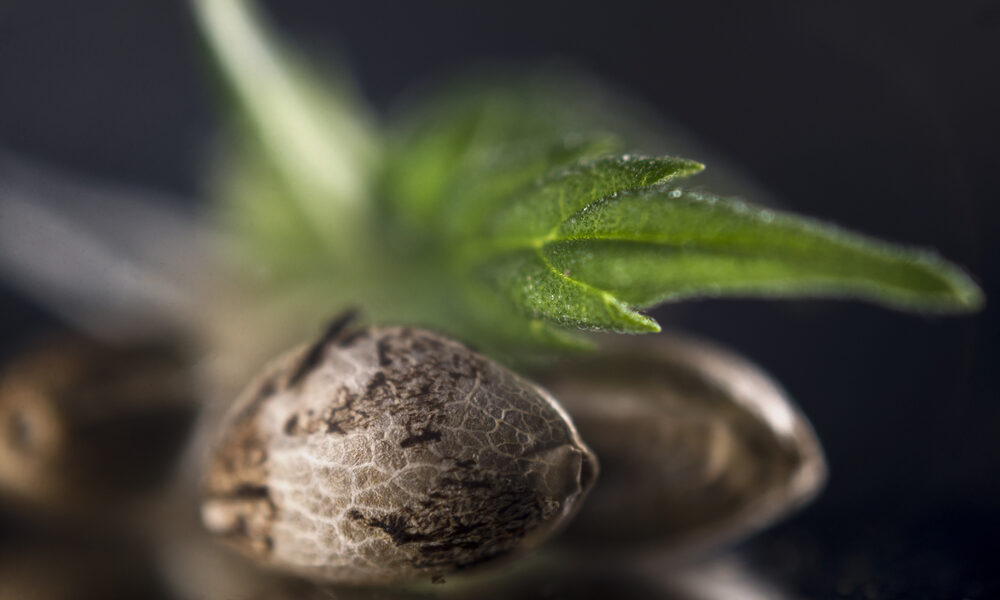Marijuana cultivation is a fine art that involves understanding the life cycle of cannabis plants. This involves understanding growth patterns, strain environment, and genetic characteristics.
One of the key aspects of growing marijuana is knowing the difference between male and female plants and how to manipulate their genetics to produce high-quality yields.
This article will guide you through the process of feminizing marijuana seeds to ensure a successful harvest.
What Are Feminized Seeds?
Feminized seeds are cannabis seeds that are genetically modified to produce only female plants. They are created through a process known as feminization, which involves adjusting the female plant’s hormonal balance to produce female seeds.
Since female plants produce the cannabinoid-rich buds sought after by medical and recreational users, feminized seeds are highly desirable among growers.
Female Seeds Vs. Male Seeds
Cannabis plants are naturally dioecious, meaning they develop as either male or female. Male plants produce pollen, while female plants produce the coveted buds, rich in THC, CBD, and other cannabinoids. The male plant’s role is to fertilize the female plant to produce seeds.
However, when growing marijuana for medicinal or recreational purposes, growers usually want to avoid male plants and focus on cultivating female plants, which are responsible for producing the potent buds.
What Are the Benefits of Feminized Seeds
Feminized marijuana seeds offer several advantages for the grower:
Choosing the Right Parent Plants for Feminized Seeds
The selection of suitable parent plants is a crucial first step in producing feminized seeds. You should choose robust female cannabis plants that possess desirable traits, such as disease resistance, high yield, and potent cannabinoid content.
The genetic compatibility between plants should also be considered to ensure genetic stability in the offspring.
How to Feminize Seeds
Several methods can be used to feminize cannabis seeds, including the rodelization method, the chemical treatment method, and the colloidal silver method.
Each technique has its advantages and disadvantages and may be more suitable for certain growers depending on their resources and expertise.
Rodelization Method
The rodelization method leverages the plant’s survival instincts to feminize cannabis seeds naturally. This approach is popular due to its simplicity and absence of chemical involvement. However, it’s less reliable than other methods like using colloidal silver or silver thiosulfate.
The process involves the following steps:
- Choose a Healthy Female Plant: Select a robust female cannabis plant that is about 3-4 weeks into its flowering phase with a good balance of leaves and buds.
- Extend the Flowering Stage: Allow the female plant to remain in the flowering stage beyond its typical harvest time. This extended period induces stress in the plant, leading to the development of male pollen sacs.
- Monitor for Male Flower Development: As the plant endures the extended flowering period, it may start to grow male pollen sacs in response to the stress of potentially not being pollinated.
- Collect and Use the Pollen: When the male sacs mature, they can be harvested for pollen, which can then be used to pollinate other female plants. The resulting seeds are likely to be feminized.
- Harvest the Seeds: After successful pollination, allow the plants to continue their growth cycle until the seeds are mature and ready to be harvested.
Chemical Treatment Method
The next method, known as the Silver Thiosulfate (STS) technique, is a sophisticated yet effective way to feminize cannabis seeds. It is particularly preferred by professional breeders and experienced home growers seeking reliable results.
Here’s how it works:
- Purchase STS Solution: Ready-made STS solutions are available for purchase, eliminating the need for complex chemical processes.
- Safety Precautions: Ensure you’re using protective gear such as gloves and safety glasses when handling STS. Plants treated with STS should not be consumed.
- Apply the STS Solution: Spray the STS solution onto the plant, especially focusing on the nodes and bud sites. The first application should be just before transitioning the plant from its vegetative stage to the flowering stage. Subsequent applications are needed every few days until the appearance of male flowers.
- Pollination and Seed Harvesting: Once the male flowers develop and start producing pollen, this pollen is used to pollinate other female plants. The seeds developed on the female plant are harvested and are feminized.
- Post-Process Plant Management: Treated plants should not be consumed post-treatment.
Colloidal Silver Method
Colloidal silver is a solution of pure silver particles suspended in distilled water. It’s commonly used in various health applications and can inhibit ethylene production in cannabis plants, leading to the development of male pollen sacs.
The process involves the following steps:
- Preparation: Choose a robust female cannabis plant to serve as your “mother” plant. This plant should possess desirable traits as it will contribute to the genetic makeup of the feminized seeds.
- Application of Colloidal Silver: Spray the colloidal silver solution onto the plant, focusing on the branches where bud development is desired. This application should be done during the vegetative stage of the plant. It’s recommended to use a colloidal silver solution with a concentration of at least 30 PPM (parts per million) for effectiveness.
- Development of Male Pollen Sacs: After regular application of colloidal silver, the female plant will start to develop male pollen sacs. These sacs contain pollen with female genetics, which can then be used to pollinate other female plants. The seeds produced from this pollination will be feminized.
- Safety and Disposal: Plants treated with colloidal silver are not safe for consumption. After the pollen is collected, the treated plant should be discarded.
Techniques for Pollination and Seed Production
The techniques for pollination and seed production are as follows:
Natural Pollination
Natural pollination is the simplest method of pollination, allowing the plants to pollinate each other naturally.
However, this method may not be suitable for all strains, as some reversed female plants may not produce sufficient pollen or their pollen sacs may not open independently.
Self-Pollination
Self-pollination involves inducing a hermaphrodite plant to pollinate itself. While this method can be effective, it carries a risk of passing on undesirable traits and genetic mutations.
Artificial Pollination
The most controlled method of pollination is artificial pollination, which involves manually transferring pollen from a reversed plant to a female plant. This allows precise control over the pollination process.
Harvesting and Processing Feminized Seeds
Once your feminized seeds are ready, it’s time for seed banks to harvest them. Harvesting too early can result in immature seeds that won’t germinate, while waiting too long can lead to seeds falling out of their pods and becoming lost.
A good rule of thumb is to look for the calyxes swelling and turning brown, indicating that the seeds inside are fully formed and ready to be harvested.
When collecting the seeds, handle them gently to avoid damaging them. The best way to do this is to use a pair of tweezers or a small spoon. Carefully pluck the seeds from their pods and place them in a clean and dry container.
Once you have collected all of your seeds, spread them out on a paper towel in a single layer and leave them in a dark and dry place for several days until they are completely dry. To store the seeds, place them in an airtight container and store them in a cool and dark place. Properly stored seeds can remain viable for years.
Common Mistakes to Avoid When Feminizing Marijuana Seeds
- Improper Selection of Parent Plants: Choosing the wrong parent plants can lead to poor-quality seeds. Always select robust, healthy female plants with desirable characteristics.
- Incorrect Application of Silver Solutions: Applying too little or too much silver solution can hinder the feminization process. Always follow the recommended dosage and apply the solution correctly.
- Inadequate Safety Measures: Safety is paramount when handling silver solutions. Always use protective gear and avoid consuming treated plants.
- Failure to Isolate Treated Plants: Treated plants should be isolated from the rest of the crop to prevent accidental pollination.
- Harvesting Seeds Too Early: Harvesting seeds before they are fully mature can result in low germination rates. Wait until the seeds are fully developed before harvesting.
- Pick reputable seed banks: Picking the right reputable seed banks will ensure you get the right seeds and that you have a germination guarantee.
The Future of Feminized Seeds
The process and technology behind feminizing marijuana seeds continue to evolve. Innovations such as tissue culture and genetic modification are paving the way for even more efficient seed production.
As the cannabis industry grows, we can expect feminized seeds to become even more prevalent, offering growers a reliable way to produce high-quality, potent buds.
FAQs
Here, we answer a few frequently asked questions about how to feminize marijuana seeds.
How Do You Make a Male Plant Female From Seed?
You cannot make a male plant female from seed. The sex of a plant is determined by its genetics at the time of germination. However, you can manipulate the genetics of a female plant to produce feminized seeds, which will grow into female plants.
How Long Does It Take To Feminize Seeds?
The process of feminizing seeds varies depending on the method used. However, it typically takes several weeks from the time you begin treating a female plant with a silver solution until you can harvest the feminized seeds.
Can a Female Marijuana Plant Produce Seeds Without a Male?
Yes, a female marijuana plant can produce seeds without a male plant through a process known as parthenocarpy or “virgin fruit” production. However, these seeds are typically not viable and will not germinate.
How Can You Tell a Female Seed?
You cannot determine the sex of a seed just by looking at it. The only way to tell if a seed is female is to grow it and wait for it to show its sex, which typically happens during the flowering stage.
How Are Feminized Seeds Created?
Feminized seeds are created by manipulating the genetics of a female plant to produce pollen. This pollen is then used to pollinate another female plant, resulting in genetically female seeds.
Can I Create Feminized Seeds From Any Strain?
Yes, any female marijuana plant can be used to create feminized seeds. However, it’s important to choose robust, healthy plants with desirable characteristics to ensure the highest quality seeds.
Is Feminized Seed Production Difficult?
Feminized seed production can be a bit complex, particularly for novice growers. However, with the right knowledge and resources, it is possible to successfully produce feminized seeds.
Conclusion
Feminizing marijuana seeds is a valuable skill for any cannabis grower. It offers a reliable way to produce high-quality, potent buds and helps growers avoid the time and resource-intensive process of growing and culling male plants.
With the right knowledge and a bit of practice, you can master the art of feminizing marijuana seeds and take your cannabis cultivation to the next level.
 Join Daily Trust WhatsApp Community For Quick Access To News and Happenings Around You.
Join Daily Trust WhatsApp Community For Quick Access To News and Happenings Around You.











